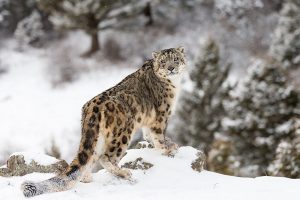
Being the largest country in the world with the vastest landmass area coverage, Russia owns the wildlife that is spread across twelve time zones. Geographically, this area begins with tundra from the northern coast to 420 kilometers to the south which then gradually turns into dense forests that covers the majority of Siberia and then going light again when entering the slope closer to the river banks. Because of the very long stretch of the Russian wildlife, there are incredibly various plants and animals living in it – from the species that are closer to the arctic to the ones that are akin to the animals that inhabit the wildlife of the South East Asia.
Red Data Book of The Russian Federation is an official document made by the government to record the rare and endangered species of flora and fauna within the territory of the Russian Federation. According to the Red Book, there is quite a large number of species need to be protected including the Siberian tiger and Amur leopard. What are other animals native to Russia? Here are top 8 animals that inhabit Russian wildlife.
1. Siberian Tiger
Living mainly in the mountain region of the Far East Russia, Siberian tiger is a part of the Caspian tiger family that inhabits the Central and Western Asia. Because of the climate condition of the natural environment the tigers live in, their fur is thicker than the tigers living in the hotter places although the base color of the fur is similar; rustic orange with thin black vertical lines. The length of the body is at least 150 centimeters with weight around 180 to 306 kilograms. Deforestation and heavy poaching caused the species to be enlisted as endangered.
2. Oriental Stork
Closely related to the European white stork, the Oriental stork once could be found in Japan, Korea, China and Russia but now extinct in Japan and the Korean peninsula. However, Japan still keeps trying to breed the bird in captivity. The Russian Red Book also enlists the Oriental stork that lives in the Far East region of the country as an endangered species. Hunting and heavy water pollution are the main cause of the rapid decrease of the number of this species.
3. Sable
If you have never seen the animal, the name may suggest it to look like a large beast. But, the truth is, it is only 38 to 56 centimeters long for the male and 35 to 51 centimeters for the female. Sables can be found in the majority of the Russian forests, from the Ural Mountains to the northern Mongolia. This small carnivorous mammal lives where pine, birch, spruce, and cedar trees are. Sables have been hunted in Russia for their glossy, beautiful fur to be sold as neck warmer – which is obviously a sad and controversial thing that sprouts a lot of protests.
4. Eurasian Lynx
This wild cat lives in Ural Mountains, Western and Eastern Siberia and is the largest species of lynx in the world. The length is around 80 to 130 centimeters and 60 to 75 centimeters tall. A Eurasian lynx weighs from 18 to 30 kilograms for male and 8 to 21 kilograms for female. The fur can change both in color and thickness depends on the weather. During the summer it is relatively short and reddish, while during the winter it gets thicker, longer, and turns into greyish brown. Unlike the other animals mentioned before, Eurasian lynx is considered the least endangered species according to the Russian Red Book.
5. Amur Leopard
The name of the species already explains from which family this animal comes from. Amur leopard is the subspecies of the leopard and it lives in the Far East region of Russian wildlife. The fur is thicker and paler in color compared to the other species of leopard due to the condition of the environment. Amur leopard is critically endangered and considered as one of the rarest cats on Earth.
6. Russian Desman
Although the looks are similar to the species that belongs to the rodent family, Russian desman is actually a part of the mole family. It is small, semiaquatic, and living in the Volga, Don and Ural River basins. Russian desmans are naturally blind just like any other mole species and finding their ways using the sensory input through the Eimer’s organs at the end of their long snouts. Just like sable, Russian desman’s fur is also highly sought and it is what makes the Russian government protect them under the law to prevent the extinction of the species.
7. Nerpa
Also known as the freshwater seal, Nerpa is the only animal you can find in and around Lake Baikal and Lake Ladoga. This mammal has become Lake Baikal’s icon and a tourist attraction on its own. The appearance of Nerpa is very much similar with the other seals with the length around 1 meter and weight around 45 kilograms.
8. Tundra Wolf
This carnivore is the subspecies of grey wolf and inhabits the Kamchatka Peninsula of the Russian territory. Tundra wolf is bigger than common wolves as it weighs up to 49 kilograms and could grow as long as 137 centimeters. Its fur is long, fluffy, soft, thick, and usually grey in color. During the winter, this subspecies only hunts and feeds on female or young reindeer, while in the summer it eats birds and small rodents.
Those are the top 8 animals that inhabit the Russian wildlife. Some are native and can only be found in Russia, some are spread outside of Russia too. Some are enlisted as endangered; some still exist in the safe number and breeding in stable frequency. Not only the animals, Russian wildlife itself is a very amazing region to be explored that has been inviting people from all over the world to come and experience.
